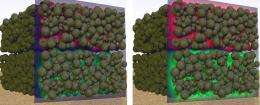September 2, 2009 feature
Renewable Energy Made by Mixing Salt and Fresh Water

(PhysOrg.com) -- When a river flows into the sea, the location is more than just a haven for water commerce. The mixing of fresh and salt water that occurs at an estuary also dissipates energy, as the different salinity waters combine into a state of less-ordered, uniform salinity. The mixing generates a significant 2.2 kJ of energy per liter of fresh water that flows into the sea.
Scientists have already designed several techniques in an attempt to harvest this energy, and have successfully generated power of about 1 kW for a fresh water flow of 1 liter per second. But these techniques are usually based on membranes through which the water flows, and problems such as high membrane cost and short lifetime are currently preventing the large-scale utilization of these techniques.
Now, Doriano Brogioli of the University of Milan Bicocca in Monza, Italy, has taken a different approach to extracting energy from salinity difference. As Brogioli explains in a recent issue of Physical Review Letters, the method is based on electric double-layer (EDL) capacitor technology.
“The main idea is that the potential of an electric double layer depends on ion concentration,” Brogioli told PhysOrg.com. “This concept is implicit in the theories concerning electric double layer (Gouy-Chapman-Stern theory), but it was not explicitly expressed before, and was not experimented. The scientific background is electrokinetics, which is the field of physics that focuses on ions and charged objects in solutions. In this sense, my study can help to understand already known phenomena in a new way.”
The EDL capacitor is made of two porous carbon electrodes immersed in salt water. The electrodes are then connected to a power supply so that one becomes negatively charged and the other positively charged. Since salt water consists of positively charged sodium ions and negatively charged chloride ions, the positive electrode attracts the chloride ions and the negative electrode attracts the sodium ions. With the help of the electrostatic force keeping the oppositely charged ions near their respective electrodes, the EDL capacitor can store a charge.
To extract the charge, fresh water is pumped into the device, causing the sodium and chloride ions to diffuse away from the electrodes against the electrostatic force. In other words, the work done by the fresh water to extract the salt water is converted into electrostatic energy, appearing as an increase in voltage between the electrodes. Overall, the system transforms mechanical work (the mixing of the salt and fresh water) into electrostatic energy that can be extracted as usable power. The only energy required by the system is the initial power source to jumpstart the capacitor, and power to pump fresh and salt water into the device.
Brogioli's experiments have shown that the EDL capacitor method is a feasible idea, and he hopes that the experimental device could be scaled up to an industrial-scale system. He calculates that the method could produce a power output competitive with the 1 kW of membrane-based methods, without the issues of expense and limited lifetime. Still, the EDL capacitor technique will face challenges of its own, such as the relatively long time it takes to change the solution, which is the main drawback of the method.
Brogioli hopes that improvements, such as a better engineered electrode structure, could further improve the performance of the technique. If so, extracting energy from salinity difference could be used for a variety of applications, although more work needs to be done before predicting the full potential. Possible uses include building small plants to power single houses and large plants on the coast in desert regions. When fully developed, the technique could provide another source of alternative energy, in addition to solar and wind energy.
“Photovoltaic solar cells are currently very expensive, and my method will be much cheaper,” Brogioli said. “I hope that my method will be similar to wind turbines in terms of energy cost. On the other hand, wind turbines are less environmentally acceptable (they are noisy, bad looking, kill birds and cover huge surfaces). When dealing with alternative energy sources, we cannot find a single, global solution, but we must find the best solution for each place. There are regions where there is no wind, but plenty of fresh water and sea water. In that place, you can use my method. In other places, it can be better to use solar energy with a concentration device, for example, or small wind turbines, biofuels, or whatever else, perhaps including fossil fuels or nuclear power. In this sense, my method is an ‘alternative’ to other ‘alternative’ energy sources.”
More information: Doriano Brogioli. “Extracting Renewable Energy from a Salinity Difference Using a Capacitor.” Physical Review Letters 103, 058501 (2009). DOI: 10.1103/PhysRevLett.103.058501
Copyright 2009 PhysOrg.com.
All rights reserved. This material may not be published, broadcast, rewritten or redistributed in whole or part without the express written permission of PhysOrg.com.


















